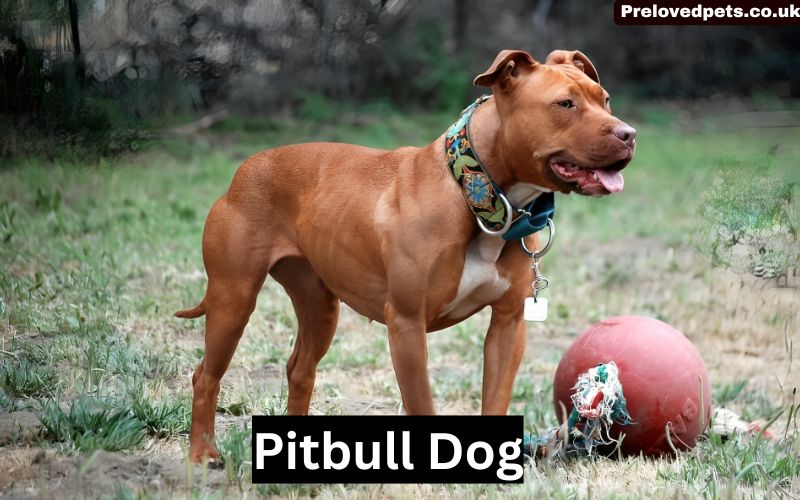Pitbull dogs, known for their strength, loyalty, and intelligence, have garnered significant attention and sometimes controversy in the world of dog breeds. Despite their tough reputation, Pitbulls are loving and affectionate companions when raised in a nurturing environment. This comprehensive guide will explore the history of Pitbulls, their physical and behavioral characteristics, training techniques, care requirements, and more.
Introduction to Pitbull Dogs
Pitbull dogs are a group of breeds that share a common ancestry, primarily originating from bulldogs and terriers. These dogs are known for their muscular build, high energy levels, and strong work ethic. Despite being misunderstood by some, Pitbulls are deeply loyal and can form strong bonds with their families. With proper training and care, they make excellent pets, service animals, and even therapy dogs.
History and Origins of the Pitbull
Understanding the history and origins of Pitbulls helps in appreciating their unique characteristics and the roles they have played throughout history.
Origins in the United Kingdom
The history of Pitbulls dates back to the early 19th century in the United Kingdom. They were originally bred from Old English Bulldogs, which were used in the cruel sport of bull-baiting. After bull-baiting was banned in 1835, breeders began crossing Bulldogs with various terriers to create a more agile and versatile dog. This crossbreeding resulted in the creation of the “Bull and Terrier” dog, the precursor to the modern Pitbull.
Development in the United States
Pitbulls were brought to the United States by immigrants, where they quickly became popular as farm dogs, guardians, and companions. In America, the breed was further developed, leading to the creation of distinct Pitbull breeds, such as the American Pit Bull Terrier, American Staffordshire Terrier, and the Staffordshire Bull Terrier. These dogs were valued for their strength, intelligence, and unwavering loyalty.
Pitbull Breeds and Variants
Today, the term “Pitbull” is often used to describe several breeds, including:
- American Pit Bull Terrier: Known for their athleticism and tenacity, this breed is the most widely recognized Pitbull variant.
- American Staffordshire Terrier: Slightly smaller and more muscular, this breed is known for its friendly and outgoing nature.
- Staffordshire Bull Terrier: The smallest of the Pitbull breeds, this dog is known for its affectionate and gentle demeanor, especially with children.
- American Bully: A newer breed, the American Bully was developed in the United States by crossing American Pit Bull Terriers with other bulldog breeds to create a more muscular and less aggressive dog.
Physical Characteristics of Pitbulls
Pitbulls are easily recognizable due to their distinctive physical traits. They are medium-sized dogs with a strong, muscular build and a confident posture.
Size and Weight
Pitbulls vary in size depending on the breed. On average, they stand between 17 to 21 inches tall at the shoulder and weigh between 30 to 60 pounds. The American Bully, however, can be heavier, sometimes weighing up to 120 pounds.
Coat and Color Variations
Pitbulls have a short, smooth coat that requires minimal grooming. Their coat comes in a wide variety of colors, including black, white, brown, blue, red, and brindle. Some Pitbulls may also have patches or a combination of colors.
Distinctive Features
Pitbulls have a broad, flat skull with a powerful jaw. Their ears are typically cropped, though natural ears are also common. They have a short, tapered tail and a strong, athletic build, giving them an appearance of power and agility.
Behavioral Traits of Pitbulls
Understanding the behavioral traits of Pitbulls is essential for potential owners and those working with these dogs.
Temperament
Pitbulls are known for their loyalty and affectionate nature. They form strong bonds with their families and are often described as “people-oriented” dogs. Despite their reputation, well-trained Pitbulls are friendly, social, and eager to please. They are also highly intelligent, making them responsive to training and commands.
Energy Levels
Pitbulls are high-energy dogs that require regular exercise to maintain their physical and mental health. They enjoy activities like running, playing fetch, and engaging in agility training. Without adequate exercise, Pitbulls can become bored and may develop behavioral issues.
Socialization Needs
Socialization is crucial for Pitbulls, especially at a young age. Proper socialization helps them become well-adjusted, confident dogs that can interact positively with other animals and people. Exposing Pitbulls to various environments, people, and situations from an early age can prevent fearfulness and aggression.
Myths and Misconceptions about Pitbulls
Pitbulls are often misunderstood due to widespread myths and misconceptions. It’s important to address these inaccuracies to better understand the breed.
Aggression and Behavior
One of the most common myths about Pitbulls is that they are inherently aggressive. While Pitbulls are strong and powerful, their temperament is largely shaped by their environment, training, and upbringing. Like any dog, a well-trained and socialized Pitbull can be gentle, loving, and well-behaved.
Legal Issues and Breed-Specific Legislation
Breed-specific legislation (BSL) has been enacted in some areas to restrict or ban Pitbull ownership. These laws are often based on misconceptions and have been criticized for being ineffective in reducing dog attacks. Advocates argue that responsible ownership and proper training, rather than breed bans, are the key to preventing incidents.
Training and Socialization of Pitbulls
Training and socialization are critical components of responsible Pitbull ownership. With the right approach, Pitbulls can become well-mannered and obedient pets.
Basic Obedience Training
Basic obedience training should begin as early as possible, ideally when the Pitbull is still a puppy. Training should focus on teaching commands such as sit, stay, come, and heel. Consistency and positive reinforcement are key to successful training.
Positive Reinforcement Techniques
Positive reinforcement, such as treats, praise, and affection, is the most effective training method for Pitbulls. Avoid harsh or punitive methods, as they can lead to fear and aggression. Instead, reward your Pitbull for good behavior and use redirection to correct unwanted actions.
Socializing with Other Dogs and People
Socializing your Pitbull with other dogs and people is crucial to preventing fearfulness and aggression. Start socialization early by introducing your Pitbull to different environments, sounds, and situations. Puppy classes, dog parks, and controlled playdates can be excellent opportunities for socialization.
Dealing with Behavioral Issues
Some Pitbulls may develop behavioral issues, such as separation anxiety, excessive barking, or destructive chewing. Address these issues by providing regular exercise, mental stimulation, and consistent training. In some cases, consulting a professional dog trainer or behaviorist may be necessary.
Health and Wellness of Pitbulls
Maintaining the health and wellness of your Pitbull is essential for ensuring a long and happy life. Understanding common health issues, dietary needs, and exercise requirements will help you keep your Pitbull in optimal condition.
Common Health Issues
Pitbulls are generally healthy dogs, but they can be prone to certain health conditions, including:
- Hip Dysplasia: A genetic condition where the hip joint doesn’t develop properly, leading to arthritis and pain.
- Allergies: Pitbulls can be susceptible to skin allergies
Grooming and Maintenance of Pitbulls
Pitbulls are generally low-maintenance when it comes to grooming, but they still require regular care to keep their coat, teeth, nails, and ears healthy.
Coat Care
Pitbulls have short, smooth coats that are easy to maintain. Regular brushing with a soft-bristle brush or grooming mitt can help remove loose hair and distribute natural oils, keeping their coat shiny and healthy. Since they have minimal shedding, weekly brushing is typically sufficient. Pitbulls only need to be bathed every few months unless they get particularly dirty or develop a skin condition.
Dental Hygiene
Dental health is crucial for all dogs, including Pitbulls. Regular brushing of your Pitbull’s teeth can help prevent dental diseases, such as gingivitis and tartar buildup. Use a dog-specific toothbrush and toothpaste, as human products can be harmful to dogs. Providing dental chews and toys can also support oral hygiene.
Nail Trimming and Ear Cleaning
Pitbulls’ nails should be trimmed regularly to prevent them from becoming too long or breaking. Long nails can cause discomfort or lead to more severe issues with the dog’s feet. If you’re not comfortable trimming your Pitbull’s nails, a professional groomer or veterinarian can help.
Additionally, regular ear cleaning is important to prevent infections, especially since Pitbulls can be prone to ear issues. Use a vet-recommended ear cleaner and gently clean the inside of the ears with a cotton ball. Avoid inserting anything deep into the ear canal.
Choosing the Right Pitbull for Your Family
When considering adding a Pitbull to your family, it’s important to choose the right dog that fits your lifestyle and household dynamics.
Adoption vs. Buying from Breeders
Adopting a Pitbull from a rescue or shelter can be a rewarding experience, as many Pitbulls are in need of loving homes. Adoption also often comes with the benefit of knowing the dog’s temperament and health status. Alternatively, if you decide to purchase a Pitbull from a breeder, ensure the breeder is reputable and adheres to ethical breeding practices. Research the breeder’s background, visit their facilities, and ask for health clearances for both the puppy and its parents.
Evaluating a Pitbull’s Temperament
When selecting a Pitbull, it’s essential to evaluate the dog’s temperament to ensure it will be a good fit for your family. Spend time with the dog, observe how it interacts with people and other animals, and ask the shelter or breeder about the dog’s history and behavior. Consider factors such as the dog’s energy level, sociability, and any potential behavioral issues.
Pitbulls with Children and Other Pets
Pitbulls can be excellent family dogs and are often very gentle with children. However, it’s crucial to supervise interactions between young children and any dog, including Pitbulls, to ensure safety. Early socialization and training are key to fostering positive relationships between your Pitbull and other pets in the household. With proper introduction and supervision, Pitbulls can live harmoniously with other dogs and even cats.
Pitbulls in Popular Culture
Pitbulls have had a significant presence in popular culture, where they are often portrayed as strong, loyal, and resilient dogs.
Famous Pitbulls
Several famous Pitbulls have made their mark in history and pop culture. One notable example is “Sergeant Stubby,” a Pitbull mix who became a World War I hero and the most decorated war dog in American history. He served alongside soldiers in the trenches, warning them of incoming attacks and saving lives.
Another famous Pitbull is “Petey,” the lovable dog from the classic television series “The Little Rascals.” Petey’s distinctive ring around his eye made him an iconic figure and helped to promote a positive image of the breed.
Pitbulls in Media and Entertainment
Pitbulls have appeared in various films, television shows, and advertisements, often symbolizing strength, loyalty, and determination. Despite the mixed portrayals in the media, many positive representations highlight the breed’s affectionate and protective nature. These appearances have helped challenge negative stereotypes and showcase the breed’s versatility and loving demeanor.
See Also: Duck Eggs




